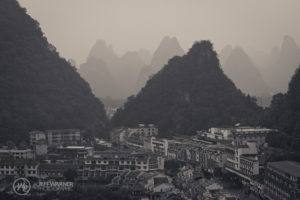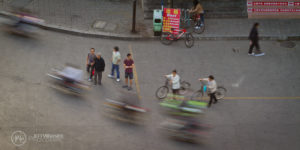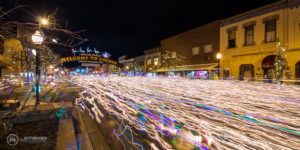This morning found me out again at 6am, wondering if the sun might actually ‘rise’ out of the haze. I climbed to the top of Xilang Hill at Yangshuo Park, where a pagoda at the tip of a spine of rock overlooks the business end of Yangshuo. Although the sunrise was something less than spectacular, the location gave an almost ‘aerial’ view of the hustle and bustle of daily life unfolding before me on this morning. I took the opportunity to capture some long-exposure images of street life from above, and then proceeded back down the narrow, steep, winding stairs and pathway that led to the main park. Older gentleman could be seen playing cards, people walking or sitting, middle-aged women dancing in a large group, many people eyeing me oddly, probably wondering what I was doing there. In turn, I wondered about them, and contemplated what changes they’d witnessed in this ‘little’ town over the last decades of relatively rapid development in Asia.
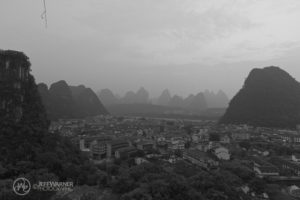 |
| Yangshuo by dawn. |
 |
| The highest pagoda on Xilang Hill, Yangshuo Park. |
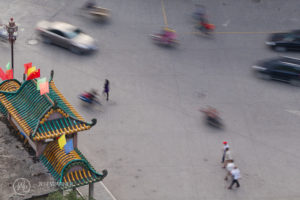 |
| Lockstep. |
 |
| Waiting. |
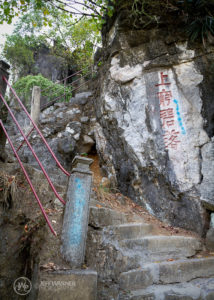 |
| The stairway and path leading to the top of Xilang Hill, Yangshuo Park. |
 |
| One of several pagodas at Xilang Hill. |
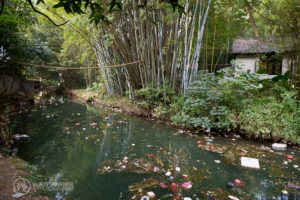 |
| The park was clean, except for this corner of it where abundant detritus was found floating in a semi-stagnant branch of the pond. |
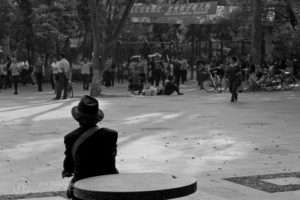 |
| Watching. |
 |
| My photographic perch, the pagoda on top of Xilang Hill. |
Prior to leaving I took a last opportunity to try and score a scarf I’d had my eye on for Heidi. The problem was that the two vendors who sold them seemed to have no interest in parting me from my money, a very unusual situation thus far on this voyage around the globe. Even after browsing for several minutes, no one came up to ask if I wanted to buy, and given the relatively inflated price tag compared to most other things in China, I started to think that perhaps bargaining was out of the question for this particular item in this particular venue. I finally engaged a younger female sales person, leaving the older male to remain sitting at his counter. Having run a bit low on yuan, I ended up bargaining by adding in the last several U.S. dollars I had been toting around in my wallet, ‘just in case’. The man behind the counter seemed either disenchanted or dully amused by my rather pathetic bargaining tactic, though he eyed the U.S. dollar bills with a curious gaze, almost like he’d never seen one before, inspecting them closely. I thought it odd, West Street having been such an attraction to tourists from around the globe for quite a few years, now; it was formerly a popular destination for off-the-beaten-track backpackers, but is now clearly a major attraction to the ‘new’ Chinese middle class.
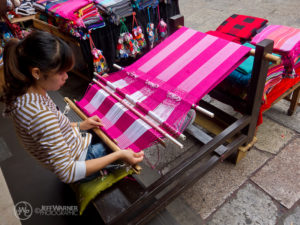
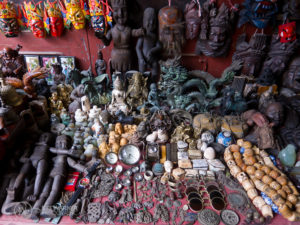 |
| West Street wares. |
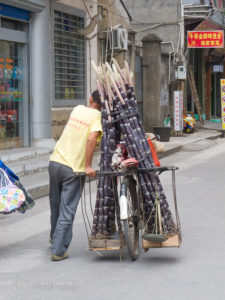 |
| Sugar cane on a bike. |
After having yet another ‘local hotel lunch’ on our last day on the road for this incredible trip, during the trip back home it finally occurred to me why they have beautiful limestone streets and people digging holes in cobbly gravel to laboriously extract sand. Sand being in low supply and high demand for construction concrete, the large supply of workers dictates that it makes more sense to build streets and sidewalks out of cut stone than concrete, stone being plentiful. Cheap labor leaves the high-demand sand to be used for construction.
Such an interesting world we live in!












